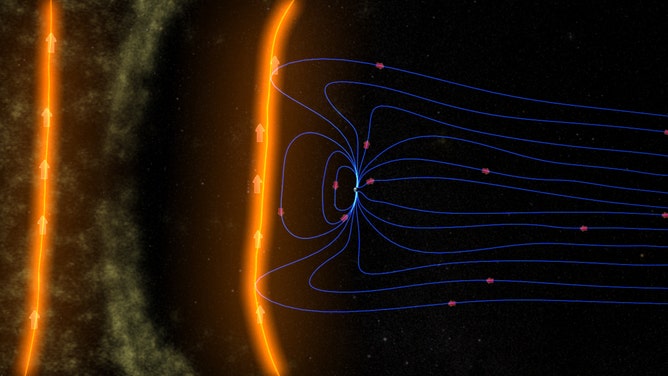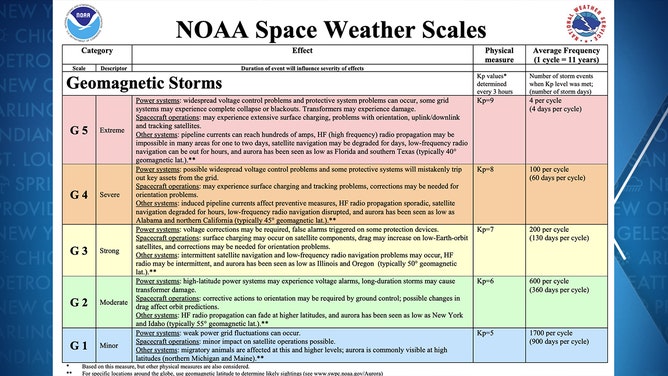What is a geomagnetic storm?
If you've ever gazed at or chased the Northern Lights, you're already familiar with the effects of a geomagnetic storm, but these storms can do more than just put on a pretty light show. These events can affect power grids, communication devices and satellite operations and pose threats to any astronauts currently living in space.
What is an aurora? The northern lights explained
Dancing across the skies in vibrant ribbons of color, auroras are one of nature’s most magnificent natural phenomena.
If you've ever gazed at or chased the Northern Lights, you're already familiar with the effects of a geomagnetic storm, but these storms can do more than just put on a pretty light show.
These events can affect power grids, communication devices and satellite operations and pose threats to any astronauts currently living in space.
Geomagnetic storms occur from solar activity. The sun is a bubbling hot cauldron of non-stop activity that occasionally gives off solar flares, which in turn can trigger what's known as a Coronal Mass Ejection (CME).
CME's will launch a stream of solar particles into space along the solar wind. If the stream is directed at the Earth, those charged particles will interact with our magnetic field, transferring energy into our upper atmosphere and causing variations in our magnetic field.

An illustration of Earth's magnetic field shielding our planet from solar particles.
(NASA/GSFC/SVS / NASA)
Geomagnetic storms have wide-ranging effects
Geomagnetic storms are harmless to human health, but they can still have a large effect on our lives.
With an agitated upper atmosphere, it can make long-range radio difficult and will frequently lead to radio blackout conditions. GPS satellites can also experience communication issues during stronger solar storms.
As the far reaches of Earth's upper atmosphere heat from a storm's effects, it can expand a bit and reach some low-altitude satellites. That can increase the drag on those satellites and alter their orbital plane.
Meanwhile, other satellites could build up static electricity charges from the solar stream of energy that could create damage if discharged. Think of it as the galactic version of scuffing your socks on the carpet and touching something metal.

A solar flare erupting on March 3, 2023. The image shows a subset of extreme ultraviolet light that highlights the extremely hot material in flares, and which is colorized in orange.
(Solar Dynamics Observatory / NASA)
Any astronauts in space could face increased levels of dangerous radiation and must be shielded.
Even here on the ground, some of the strongest solar storms can reach low enough altitudes to cause voltage surges in power grids that can knock them out, as Montreal and Quebec suffered during the great solar storm of March 13, 1989.
THE DAY THE NORTHERN LIGHTS COVERED THE PLANET: HISTORY OF EARTH'S GREATEST SOLAR STORMS
The most well-known effects are the Northern Lights, as they can put on a vivid, colorful display at night during geomagnetic storms. As charged particles interact with oxygen and nitrogen in the atmosphere, it briefly energizes the molecule, giving off light as it de-energizes.
7 FACTS ABOUT THE NORTHERN LIGHTS
If the storms are strong enough, the aurora display can reach far south into the U.S., even to California and Texas during the most intense storms.
NOAA's 5-point Geomagnetic Storms Rating Scale
To help those who depend on systems that could be affected by such solar storms, NOAA has developed a 5-level scale that ranges from G1 to G5 to rate any incoming geomagnetic activity, giving a crucial way to quantify the expected impacts.

(NASA)
G1 - Minor
G1 storms may trigger weak power grid fluctuations and minor impacts on satellite operations. But it means a good show of the Northern Lights up in Canada and Alaska. NOAA estimates G1 conditions may be in effect for 900 days per 11-year (roughly 4,000-day) solar cycle.
G2 - Moderate
NOAA suggests that high-latitude power systems may experience voltage alarms while long-duration G2 storms may cause transformer damage. HF radio propagation may also fade at higher latitudes.
Views of the Northern Lights may eke down into the far northern reaches of the U.S. These G2 conditions are around on average for about 360 days of the 11-year solar cycle.
WHAT IS THE 11-YEAR SOLAR CYCLE
G3 - Strong
Once storm levels reach G3, intermittent satellite navigation and low-frequency radio navigation problems may occur, and HF radio may be intermittent, NOAA says. Voltage corrections may be needed on power systems, and false alarms may be triggered on some protection devices.
According to NOAA, the Northern Lights can reach as far south as Washington, Oregon and Illinois with this kind of storm activity.
Forecasters say these conditions may be observed on average about 130 days per 11-year solar cycle.
G4 - Severe
Power system administrators may be feeling like their hands are getting full as there could be widespread voltage control issues. Satellite and space operations may see surface charging and tracking issues.
Satellite navigation could be degraded for hours, HF radio propagation would be sporadic, and low-frequency radio navigation could be disrupted. On the literal bright side, the Northern Lights may be seen as far south as Alabama and Northern California.
Forecasters estimate these conditions occur for about 60 days total over any given 11-year solar cycle.
G5 - Extreme
Luckily, storm levels of this magnitude are relatively rare. Still, when they occur, power systems may see widespread voltage control problems and some grid systems may experience complete collapse or blackouts, and transformers may suffer damage.
Pipeline currents could reach hundreds of amps, HF radio propagation may be impossible in many areas for 1-2 days, and satellite navigation may be degraded for days as well, NOAA says.
But if the skies are clear, a brilliant and intense display of the Northern Lights may reach as far south as Florida and Texas.
These kinds of strong geomagnetic conditions may only appear around four days per 11-year solar cycle.
You can track the current geomagnetic activity via NOAA's Space Weather Prediction Center.
Geomagnetic storms are expected to become more frequent in the next few years as the sun begins to move into the solar maximum phase of its 11-year cycle.
